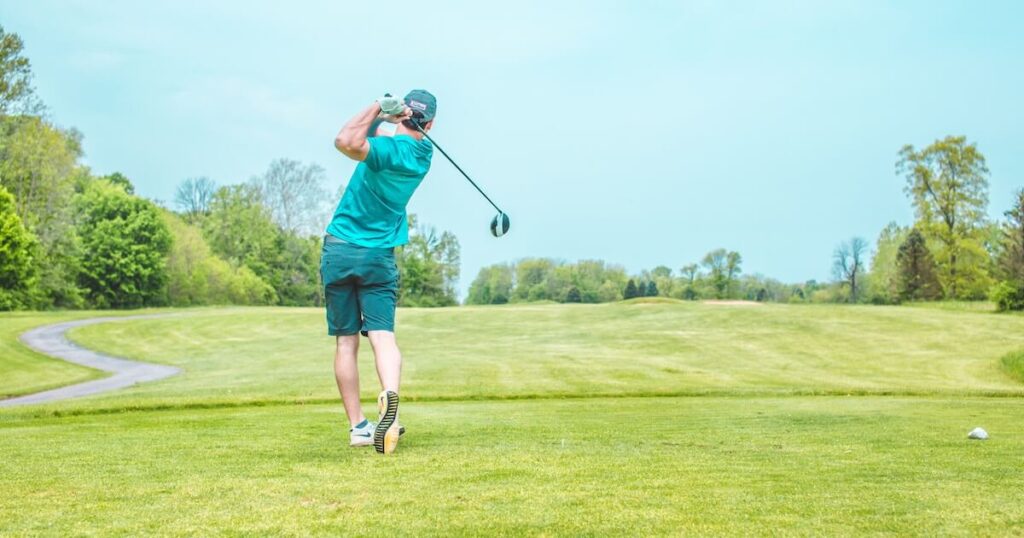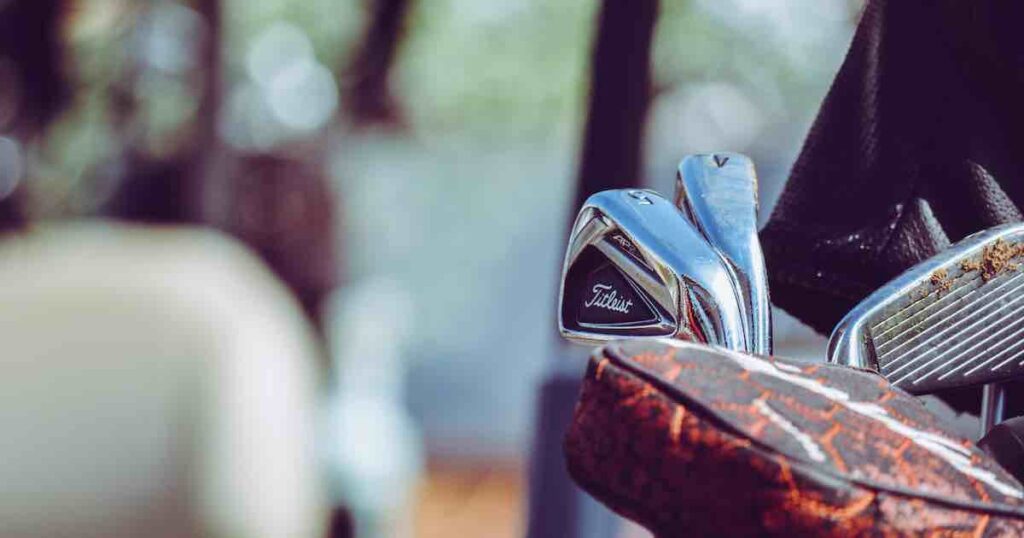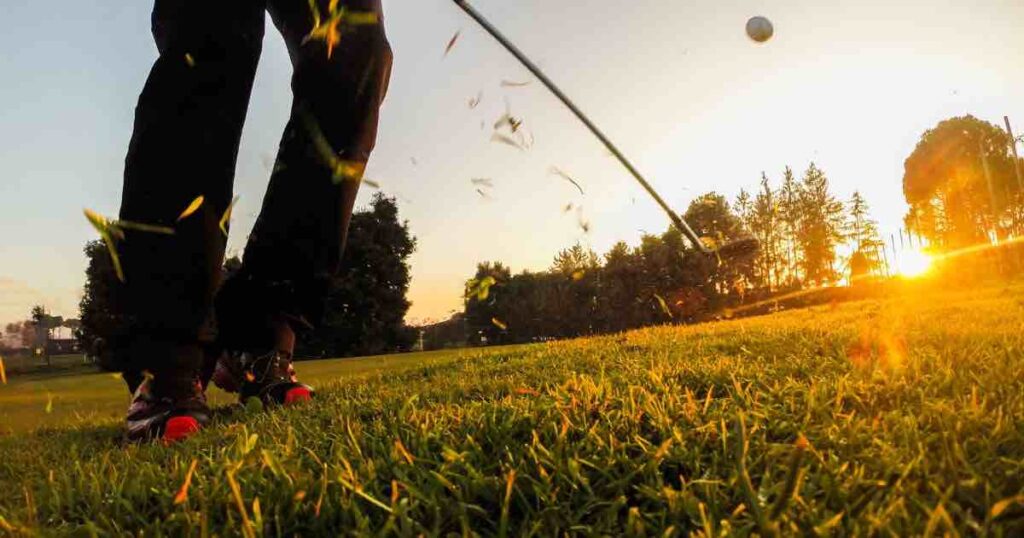Chipping is fundamental to the game of golf and is crucial in helping you save strokes around the green. Well-executed chip shots can often be the difference between saving par and dropping unnecessary shots. Therefore, it is a vital part of any golfer’s short game. However, while chipping may seem straightforward, it requires a different stance, grip, and swing than your regular iron shots. In the following sections, we will cover the fundamentals of how to chip in golf, helpful chipping practice drills, and tips for controlling the distance of a chip shot.
What is a Chip Shot in Golf?

The concept of chipping revolves around hitting a shot with enough loft to clear any obstacles but also ensures that the ball spends more time rolling on the green than flying through the air. Chip shots are typically used when you are near the green but not close enough to putt. The objective is to land the ball on the green with the right speed to roll towards, and potentially into, the hole.
Chipping comes into play in various scenarios during a round of golf. Whether your ball is just off the green or you’re faced with a hazard such as a bunker or water body near the green, a chip shot can help you clear the obstacle and position the ball for a short, makable putt. Understanding and learning the basics of chipping is a critical aspect of becoming a better golfer.
Ball-Turf Interaction in Chipping
Ball-turf interaction refers to the effect that the contact between the ball, clubface, and turf has on the outcome of a golf shot. This interaction is particularly crucial in chipping, where the objective is to loft the ball with precision and control.
Like all iron shots, the goal in chipping is to strike the ball first before making contact with the turf. This clean contact allows the clubface to impart spin on the ball, helping to control its trajectory and roll once it lands on the green.
If the club hits the turf before the ball, known as a ‘fat’ shot, the result is often a chip that comes up short of the target. This happens because the club’s energy is absorbed by the turf before it can be transferred to the ball.
Conversely, if the club strikes the ball without interacting with the turf – referred to as a ‘thin’ shot – the result can be a chip that flies the green, as the lack of friction from the turf causes the ball to launch with excessive speed.
So, how does one achieve the ideal ball-turf interaction in chipping? As we will see below, the key lies in having the correct setup, grip, and swing mechanics to achieve a clean, descending strike on the ball.
The Correct Golf Setup for Chipping
Adopting the correct stance will help you execute a successful chip shot in golf. While it shares some similarities with a regular golf swing setup, there are distinct differences that you need to understand and apply.
Chipping Posture
For chipping, maintain a straight spine and let your shoulders depress down and back. Bend forward from the hips, allowing your arms to hang directly below your shoulders. This posture is similar to that of a full swing, but you will bend slightly more forward for a chip shot.
Stance and Ball Position for Chipping
When chipping, your stance should be narrower than it is for a full swing, with your feet closer together. The ball position should be in the middle of your stance, directly below your belt buckle, or slightly towards your back foot. This is unlike a regular golf swing, where the ball is typically positioned more forward in the stance.
Weight Distribution for Chip Shots
Weight distribution is vital in chipping. Most of your weight (about 60-70%) should be on your front foot or left side for right-handed golfers. This helps promote a downward strike on the ball, which is crucial for a successful chip shot.
Alignment for Chip Shots
In terms of alignment, aim your clubface directly at the target. Your feet, hips, and shoulders should be slightly open relative to the target line. This open alignment helps to promote a slight in-to-out swing path, which is ideal for chipping.
Correct Grip for Chipping
One of the most impactful elements of a successful chip shot is maintaining the correct grip. While the grip style should be roughly the same as your normal golf grip, some adjustments can be beneficial.
First, you should grip lower on the handle, also known as ‘choking down’ on the club. This gives you better control over the clubface during the shot. Second, your grip pressure should be light and relaxed, around 3 out of 10 on the pressure scale. A lighter grip allows for better feel and control, helping to ensure clean contact with the ball.
The trail hand plays a crucial role in the chipping grip. By applying slight pressure from the trail hand, you can keep your lead wrist flat through impact, allowing your hands to reach the ball first without excessively flipping or scooping the club.
Club Selection for Chipping
Selecting the right club for a chip shot depends mainly on the distance to the hole and the ball’s lie. In general, the further you are from the hole, the less lofted club you will want to use to allow for more roll.
For shorter chip shots, wedges are often the go-to clubs, providing the necessary loft to clear any immediate obstacles and stop quickly on the green. For longer chip shots, where you need the ball to roll further, a less-lofted club like a 7 or 8 iron might be a better choice. You will need to practice with these different clubs to get a feel for how far the ball rolls with each.
The lie of the ball also influences club selection. If the ball is sitting up nicely on a fairway or fringe, you have more options and can choose based on distance. However, if the ball is in the rough or a bad lie, a wedge with more loft may be necessary to get the ball up and out.
Swing Mechanics for Chipping
Just like a full golf swing, hitting a chip shot involves the same series of steps: the backswing, downswing, and follow-through. But with its own nuances.
Backswing
The backswing in a chip shot is shorter than in a full golf swing. The club should be taken back primarily using the shoulders, not the wrists or hands. The wrists should remain stable throughout the backswing. The height of your backswing will determine the distance your ball travels. For shorter chips, a smaller backswing is required, whereas a longer chip would require a slightly larger backswing.
Downswing
Initiate the downswing by turning your body towards the target, allowing the arms and club to follow naturally. It’s essential to maintain the angle in your wrists established in the backswing to ensure that the hands lead the clubhead into the impact, promoting a descending strike on the ball. This helps to create the optimal ball trajectory and necessary spin, which increases distance control.
Follow-Through
In the follow-through, your body should continue rotating towards the target until the club reaches waist height. The length of your follow-through should mirror your backswing. Your weight should finish predominantly on your front foot, and the clubface should remain square to the target line. This helps to control the direction and distance of the chip shot.
Practice Drills for Chipping
Improving your chipping skills requires consistent practice and effective drills. Here are some practical exercises that can help you enhance your precision, control, and consistency when chipping.
Three Foot Drill
This drill is about improving accuracy by focusing on getting the ball to settle within three feet of the hole. Place a circle of tee markers three feet around the hole and practice chipping into this zone from various distances with different clubs. Over time, this drill will help you gain better control and feel in your chipping.
Hula Hoop Chipping Drill
The goal of this drill is to hit chip shots that land close enough to the hole to set up an easy one-putt. To do this, place a hula hoop or similar marker around 3-4 feet from the hole. Your aim is to chip the ball so that it lands within the hoop. This drill helps improve distance control and judgment for where to land the ball on the green.
Maintain the “Y” with an Alignment Stick
This drill focuses on maintaining the correct arm and club alignment during the chipping swing. Set up for a chip shot with an alignment stick along the line of your club and extending up your left side (for right-handed golfers). As you swing, maintain the ‘Y’ shape formed by your arms and the club. This drill can help ensure a consistent, effective chipping swing plane.
Midway Target Practice
Choose a midway point between your ball and the hole, then aim to land your chip shots at this target. This drill is handy when practicing uphill or downhill chip shots, helping you to better judge the effect of slopes on your chips.
The key to improving your chipping lies in consistent practice and focusing on technique and feel. These drills offer a great starting point to hone your skills and lower your scores.
Final Thoughts: How to Chip in Golf
While it may seem like a secondary skill in the grand game of golf, chipping is a cornerstone to achieving lower scores and improving your performance. As we’ve discussed, understanding the basics of ball-turf interaction, proper setup and swing, and learning distance control are all critical elements in refining your chipping skills.
However, the most critical factor in improving your chipping game is consistent practice. Learning how to chip in golf can only be perfected through repetition. It allows you to build muscle memory to execute a reliable and repeatable chipping stroke. So use the chipping drills mentioned and keep developing your skills. Your scores will thank you for it!




